Imagine visiting Target and finding out you have to go through a labyrinth or solve sudoku before you can check out. Are you going to return to that store or opt for Walgreens across the street, which makes it quick and easy to make a purchase?
Unless you’re addicted to puzzles, you’d probably go for the latter. And in the online world, a competitor is never more than a few clicks away.
So, how do you know what kind of customer experience you provide? You measure your Customer Effort Score (CES)!
This article will help you figure out how to gather and analyze CES data with a simple survey.
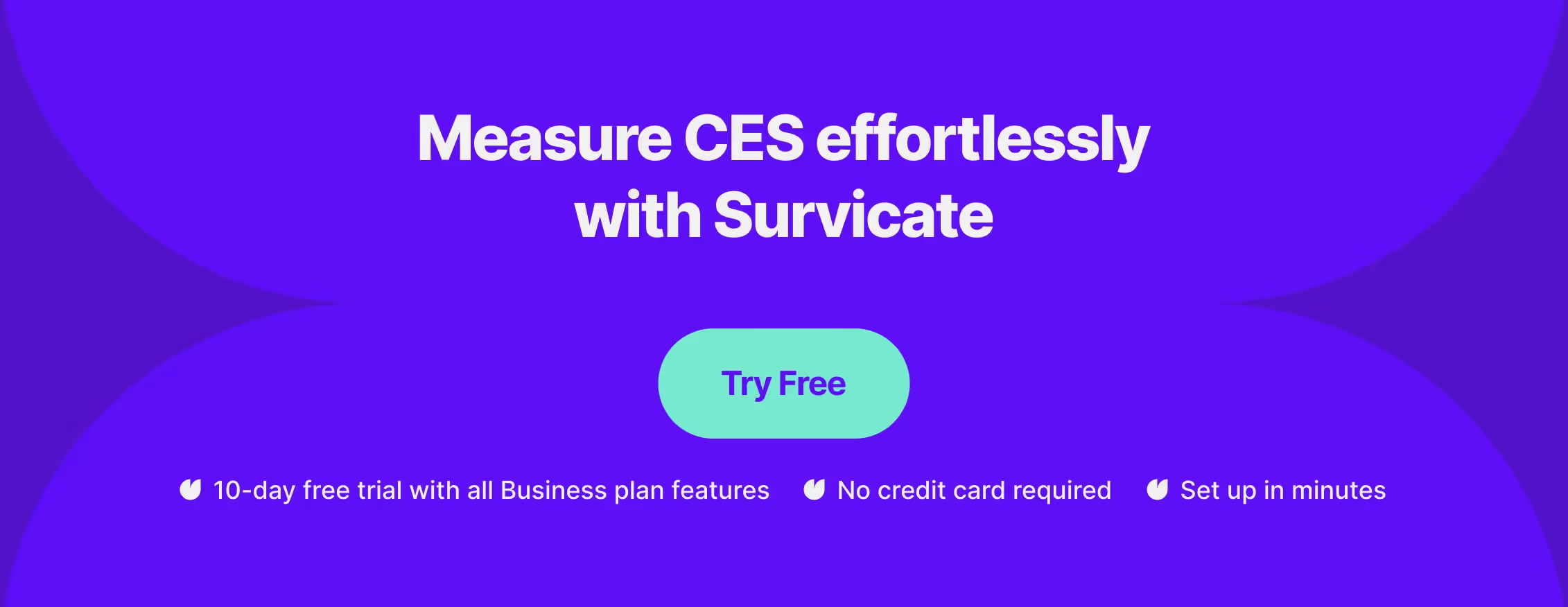
What is the customer effort score (CES)?
The Customer Effort Score is a customer experience metric that measures how much effort your customers put into interactions with your company. It can be done with a single question, but an additional 2-3 can give you a lot more insight.
According to a study by Gartner, which developed CES in 2010, a good Customer Effort Score (CES) gives you a 94% chance that a customer will repurchase from you or prolong a subscription. That’s a powerful metric for anyone who wants to retain their customers for as long as possible.
A CES survey asks customers whether an interaction like
- buying a product, service, or subscription
- experimenting with a new feature
- contacting support team
- reading a help center article
was a high- or low-effort experience.
For instance, a customer interaction would be considered high-effort or “extremely difficult” if a person
- needed to be transferred between multiple departments,
- had to switch between different channels like email to social media, or
- didn’t even get their issue resolved.
On the other hand, if they got their solution quickly and without much effort on their part, such an interaction would likely be considered “extremely easy.”
According to research by Gartner, HBR, and many more, the CES score is the strongest indicator of predicting customer behavior for repurchasing.

Why is a high customer effort score important?
Customer effort score surveys have more benefits than just letting you know whether a client was particularly happy or unhappy with an interaction. The customer effort score is a valuable metric in predicting growth, profit, customer retention, and churn.
1. CES surveys increase customer loyalty and retention
Even if a customer has experienced difficulty with your business, something as small as being asked about it may help them feel more taken care of.
And when the problem is fixed, you have a great foundation for a good customer-business relationship.
What's more, HBR reports that 88% of customers who claim to have had a relatively easy experience plan on increasing their spending at a given company.
2. A good CES score can reduce customer service costs
Use CES survey data to find customer pain points and struggles. A low level of effort required to make a purchase or resolve an issue means less strain on your customer service team.
They will receive fewer inquiries to fix problems or provide information. This allows you to have a smaller team who can be compensated more on the same budget.
3. A high CES can help minimize customer churn
This is particularly important for SaaS businesses, which, on average, have a 5-7% churn rate.
You want to use the CES metric and the data it provides to minimize that percentage. A smooth customer experience means loyal clients and lower customer churn.
Loyal clients will generate more profit than potential new ones, who may abandon their subscriptions soon after purchasing. For SaaS companies, customer loyalty is the foundation of a successful business.
4. Customers who give high CES scores are likely to repurchase
The Gartner study showed 94% of customers with effortless experiences intend to make another purchase at a given business.
The same study showed only 4% of customers who had to struggle had any intention of further business with a company.
It’s easy to deduce that the easier their customer experience, the more likely a business will continue to profit off of a given customer.
5. Businesses with a low customer effort score may lose out due to unfavorable reviews
Unhappy customers are likely to cost the company more than indifferent ones. They may spread negative reviews, cease future purchases, and discourage potential new customers.
With Survicate, you can send, track, and analyze CES surveys to win lasting customer relationships. Our AI survey creator and templates library make it effortless to get your survey up and running. Valuable data could be just a few clicks away!
When to measure customer effort score?
You won’t get valuable data if you don’t conduct a CES survey at the right time. Ideally, it should be immediately after specific transactional interactions with the company or during specific customer journey touchpoints.
This is because a CES survey is a transactional survey, meaning, it’s tied to a specific touchpoint.
Other types of surveys, such as the Net Promoter Score, can be both relational and transactional. A relational survey gives you a more holistic view of the customer experience.
If you send a transactional CES survey immediately after an interaction, the experience is fresh in your customer’s mind, so you’ll get a more accurate score than if you were to wait a while.
Yet, there is one case in which it makes sense to wait. If your service involves a recurring subscription (SaaS), you may want to send out an email, let’s say, about a week in, after the customer has had a chance to use essential or new features.
The best moments to run a transactional customer effort score survey include after the following events:
A chat with customer support or resolved email support ticket
Your CES score is a powerful tool for measuring the quality of your customer support. A chat immediately followed by a quick CES survey may tell you whether your team is successful in helping customers overcome obstacles.
When it comes to support tickets, you may want to wait about 20 minutes after it is resolved to reach out with a CES survey. Customers don't always immediately know whether their issue was worked out.
Use of a new feature
Product teams have to be aware of customers' experiences with new features. A quick pop-up survey can help them assess the usability of new functionalities.
Especially if a feature is still in beta testing, a CES survey can help identify struggles that can be fixed before the feature becomes fully available.
A finalized purchase
After purchasing a product or service subscription, customers can let you know how easy the process was. The easier the check-out process is, the more purchases you are likely to make.
Collect CES feedback to find any sore points that may lead customers to abandon carts or neglect to finalize the payment.
A subscription sign-up post a free trial period
If a customer decides to purchase a subscription after a free trial period, they are likely to be satisfied with your service so far. It means they want to continue using your product and exploring new capabilities.
Customers who are at least somewhat satisfied will be glad to let you know if anything's wrong. This is a good opportunity for open-ended questions, as customers will already have something to say about your product.
A service-related experience, like reading a knowledge-base article
If a customer finds that reading a help center article or FAQ section did not resolve their issue, you may want to optimize the content on those pages. Remember, the better those pages are, the less strain on your customer service team.
Do not run CES surveys randomly or at “regular intervals.” There are other types of surveys for that purpose, such as relational NPS.
The differences between net promoter score, customer satisfaction, and customer effort score surveys
There are three principal types of surveys that rate customer satisfaction and loyalty:
- Net Promoter Score (NPS)
- Customer Satisfaction (CSAT)
- Customer Effort Score (CES).
Net Promoter Score
The Net Promoter Score (NPS) measures long-term customer loyalty. This is the survey you should run at regular intervals. Learn more in our Net Promoter Score Guide. We have a ready-to-send NPS template you can use to gather such data.
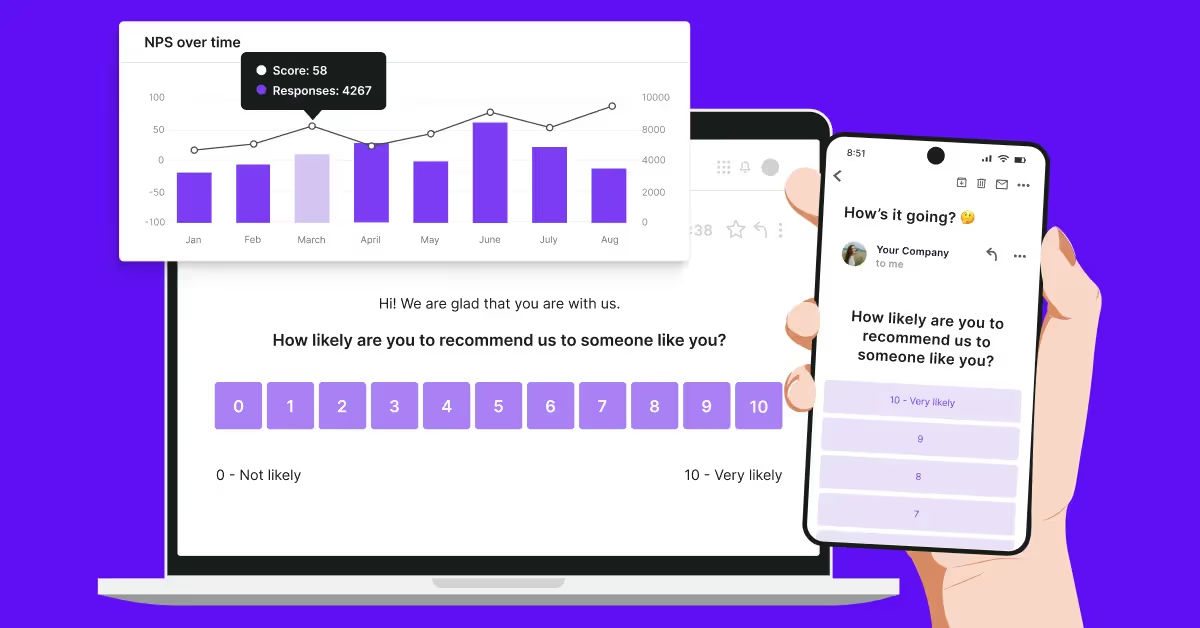
Customer satisfaction score
The Customer Satisfaction Score (CSAT) can be a relationship or transactional study metric. You should run this survey after a customer has been with you for a while. It measures general customer satisfaction with your product and service. Of course, we also have a ready-to-send CSAT survey template.

Customer effort score
The Customer Effort Score (CES) measures satisfaction with a particular interaction. It judges a single touchpoint, and it is a purely transactional metric. Run CES immediately after an interaction.\These surveys serve different goals and should be conducted at different times. If you confuse the three, you may end up with

🧨 inaccurate data
🧨 irritated customers
🧨 a waste of resources
If you use CES, NPS, and CSAT correctly, these metrics supplement each other. But they are not interchangeable.
How to build a CES survey?
Time is key—with Survicate, your survey could be up and running within minutes. The quickest way to start is to click “Use this template” below:
Sign up for free, or if you already have an account with us, the link will take you straight to the survey editor. The most popular survey questions will be set and ready.
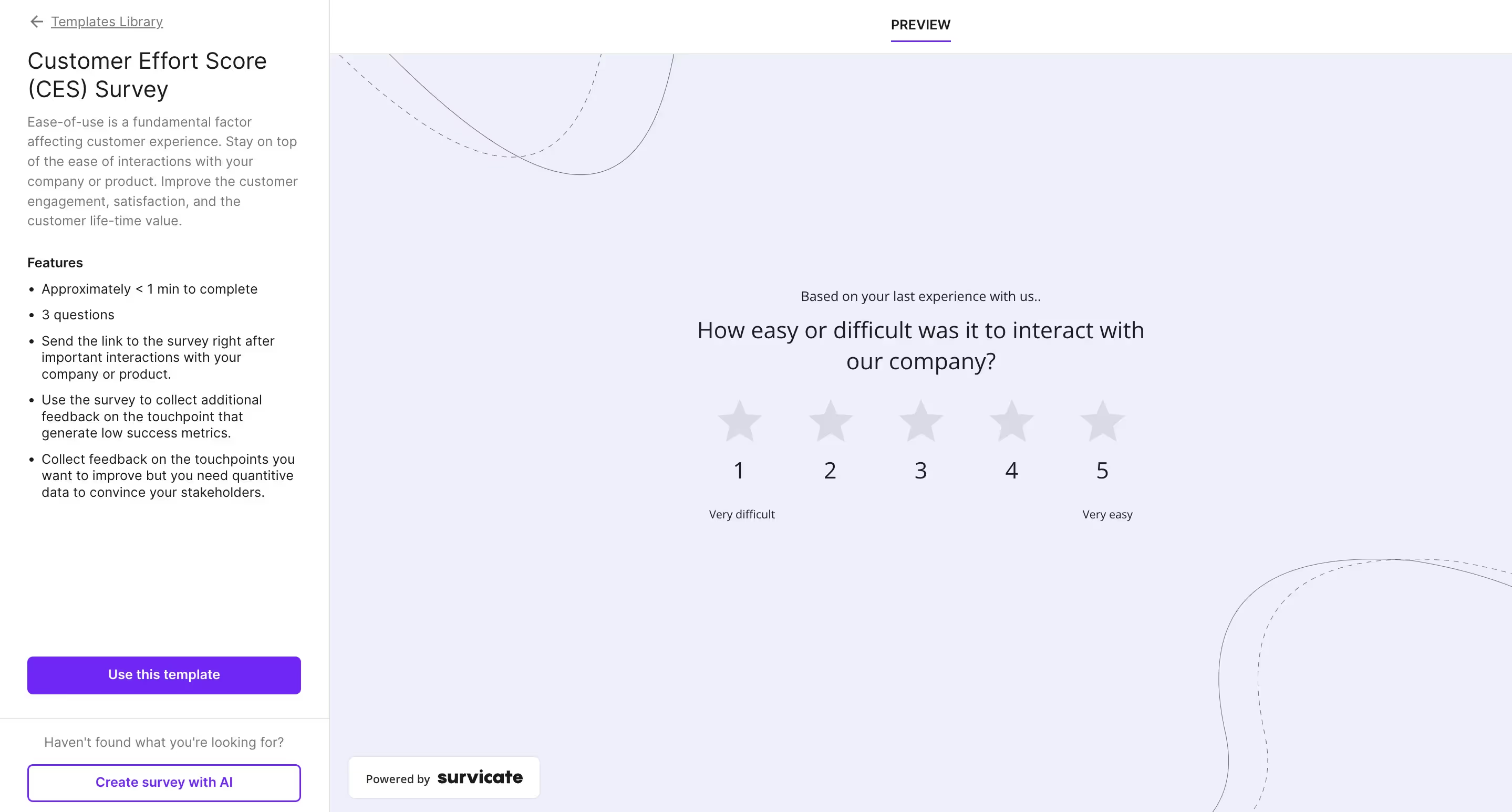
Many customers fill out surveys on mobile devices. Fortunately, Survicate surveys are 100% responsive. This means you and your customers can communicate on all types of devices.
Create and modify survey questions and the look of the survey
You can modify, add, or remove questions or even start from scratch if you have particular ideas.
Click through the preview on the right to see what your customers will see.
Easily modify the content of your questions and answers, change around fonts, colors, and backgrounds.

When scripting your questions, be friendly and conversational. There's a reason customers prefer the word “easy” over “effort”. Our templates take that into account, so leave them as they are if you are not sure about your wording.
You can even remove our branding and add your own.
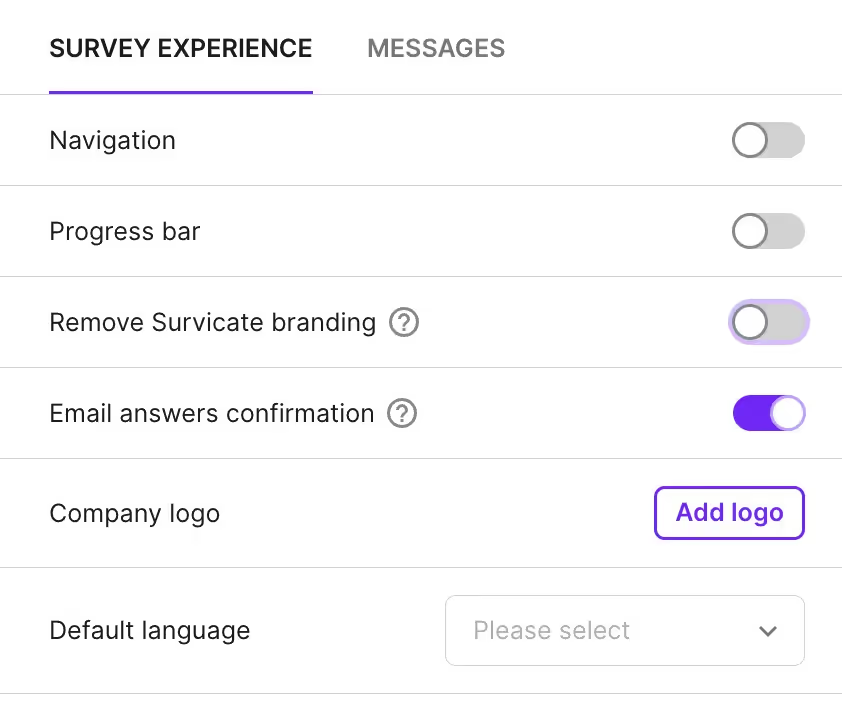
You can choose whether you want the answers on a Likert scale, numbered scale, or whether you prefer a smiley scale 🙂.
Set up survey logic to create various paths for respondents. You can add the option of skipping specific questions based on the previous responses, bringing new branches, and even segmenting users.
Lastly, at Survicate, we always thank the customer for sharing their experience.

Configure your survey
Set up how you want to identify your respondents, whether you want them to be able to fill out the survey multiple times and set your end date.
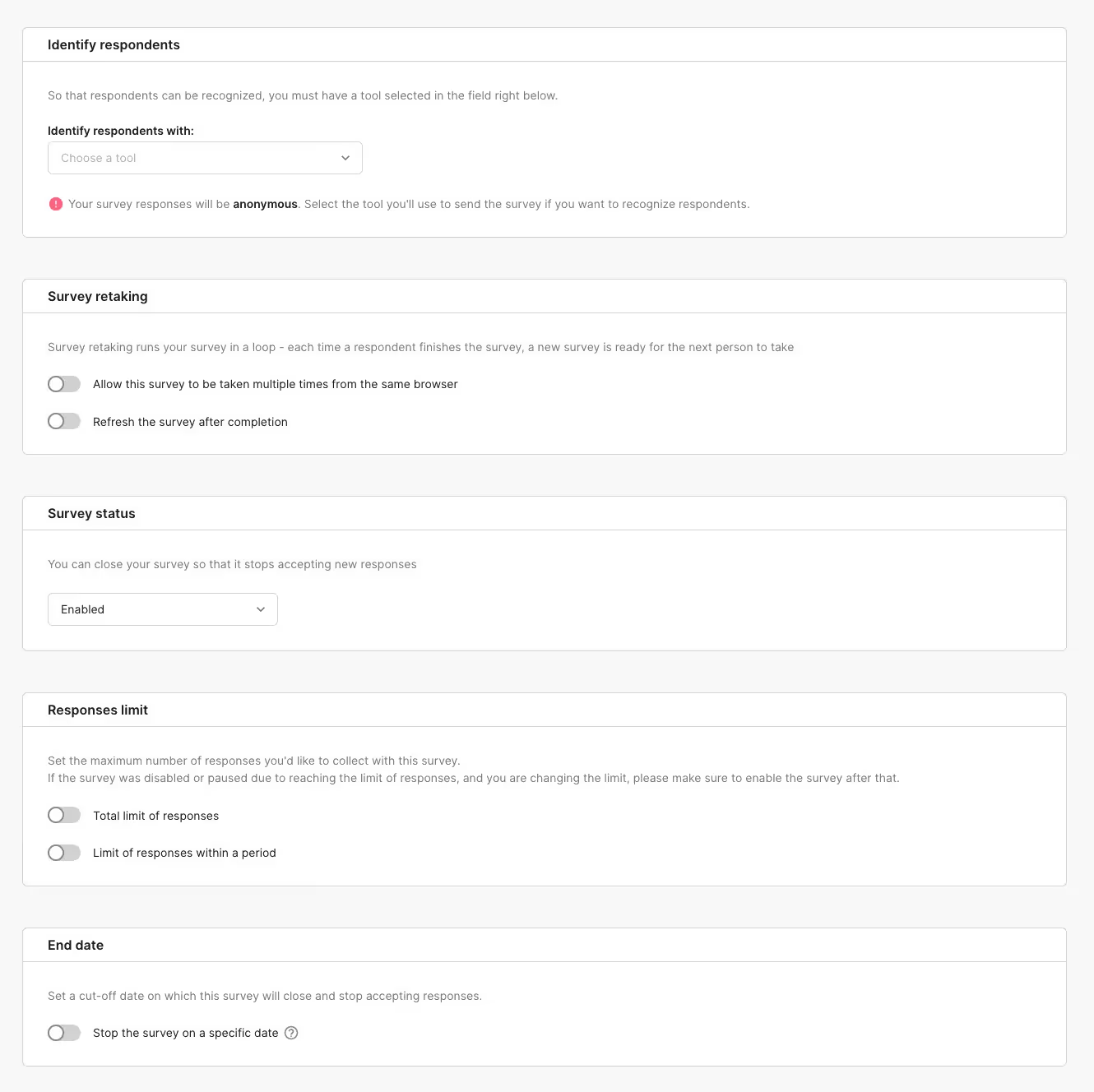
Make sure you get notified about responses
Connect the survey with one of our integrations. Many, like Slack or Microsoft Teams, can notify you about responses with a method of your choice.

Survicate offers many other integrations, like with HubSpot or Braze that help you manage feedback better. For improved distribution, connect our tool to ESPs like MailChimp and ActiveCampaign.
You’ll get a link and a preview of what your survey might look like in an email:


Or whatever distribution channel you choose.
Send or trigger CES surveys by events
Survicate offers email or sharable link surveys, website pop-ups, in-product surveys, and mobile app surveys. Click through the Survicate dashboard to find what kind will fit your needs most.
You can configure our surveys in a way that will allow them to be triggered by events. Since CES surveys should happen immediately after key interactions, you don't want to have to send them out manually each time.
You can do this in 3 ways:
- Create an email or sharable link CES survey and set up automation via your ESP.
- Create a website or in-product survey and install a tracking code.
- Create a mobile app survey and pass events from your app to Survicate.
Check out our Help Center to learn how to:
- Target website surveys by JavaScript events by installing a tracking code
- Set up targeting on mobile app surveys
Analyze responses from your survey
As soon as you receive your first responses, you’ll be able to analyze them within the Survicate dashboard:
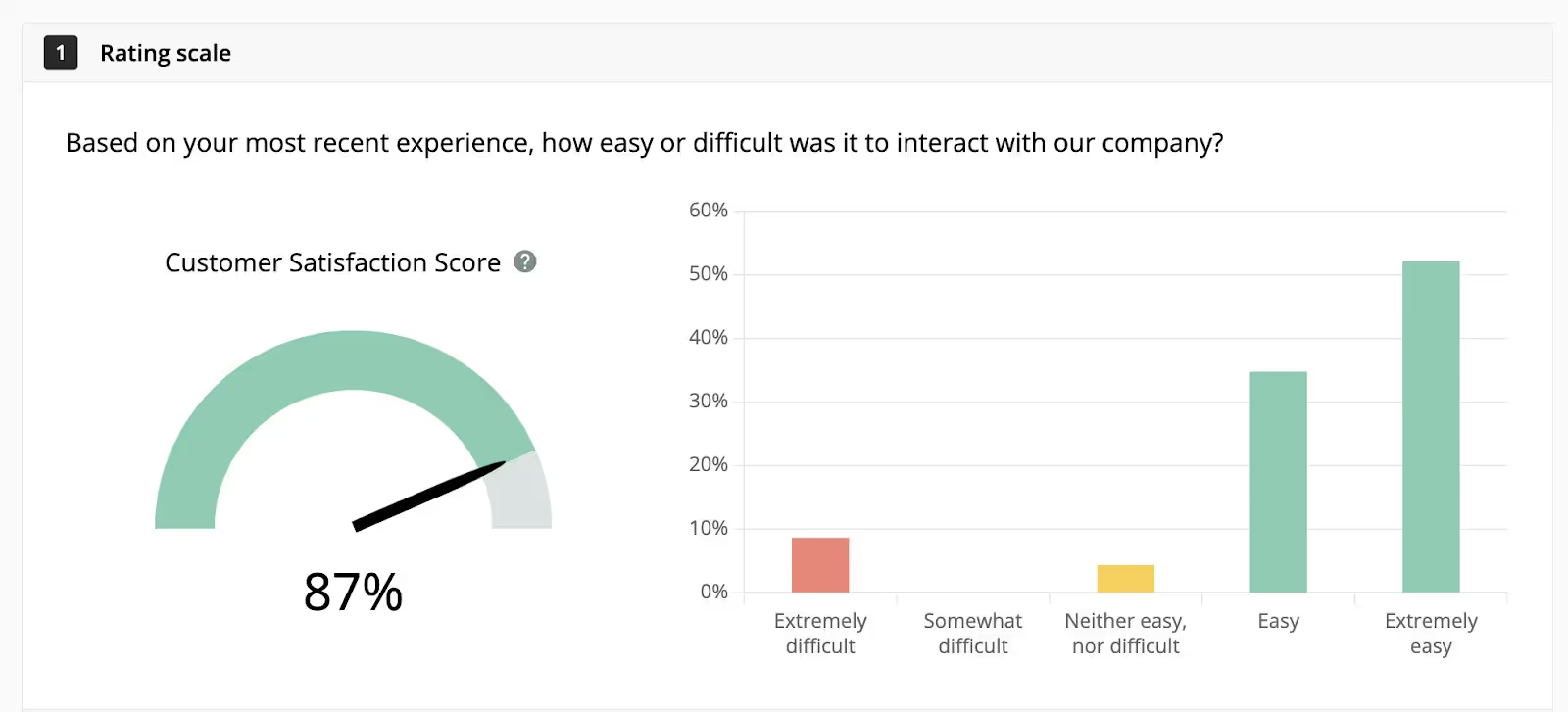
And look, there is already some actionable data you could use to improve your CX:
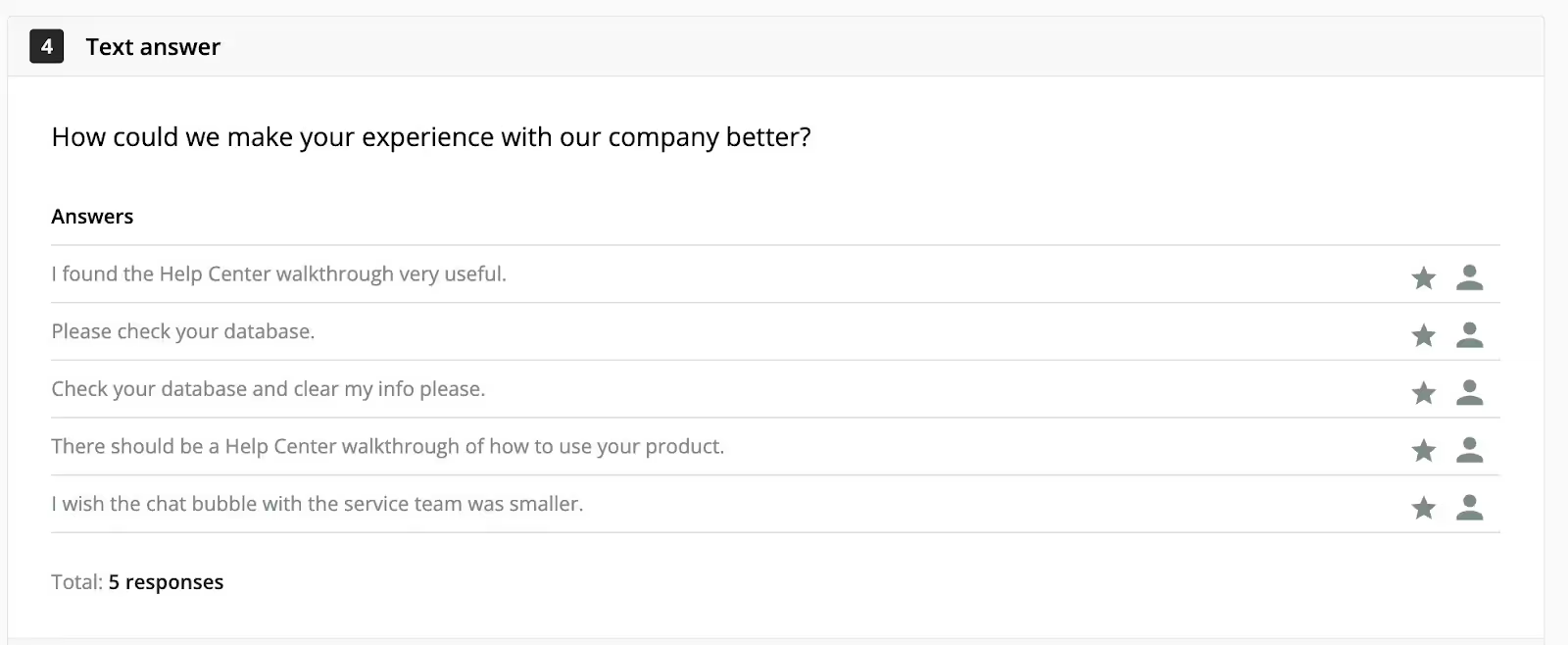
To analyze text answers more effectively, you can try our AI-powered Insights Hub. It will automatically categorize your customer feedback into topics, and bring out the insights within. For more detailed queries, you may use the conversational Research Assistant, that will answer all your questions basing on the feedback you got.

💡 Tip: You can aggregate all the customer feedback you've collected, so online reviews, user interviews, customer support interactions.
What to ask in a customer effort score survey?
Let’s have a look at the most up-to-date and actionable survey questions you can ask in a Customer Effort Score survey.
If you'd like to ask the best customer effort score question, consider using one of these ⤵️
- Based on your most recent experience, how easy or difficult was it to interact with our company?
- Were you able to accomplish your goal?
- What prevented you from achieving your goal?
- How could we make your experience with our company better?
- Was this article helpful?
Apart from the main customer effort score question, we recommend choosing one or two follow-up questions: another closed-ended one, and an open-ended question to finish.
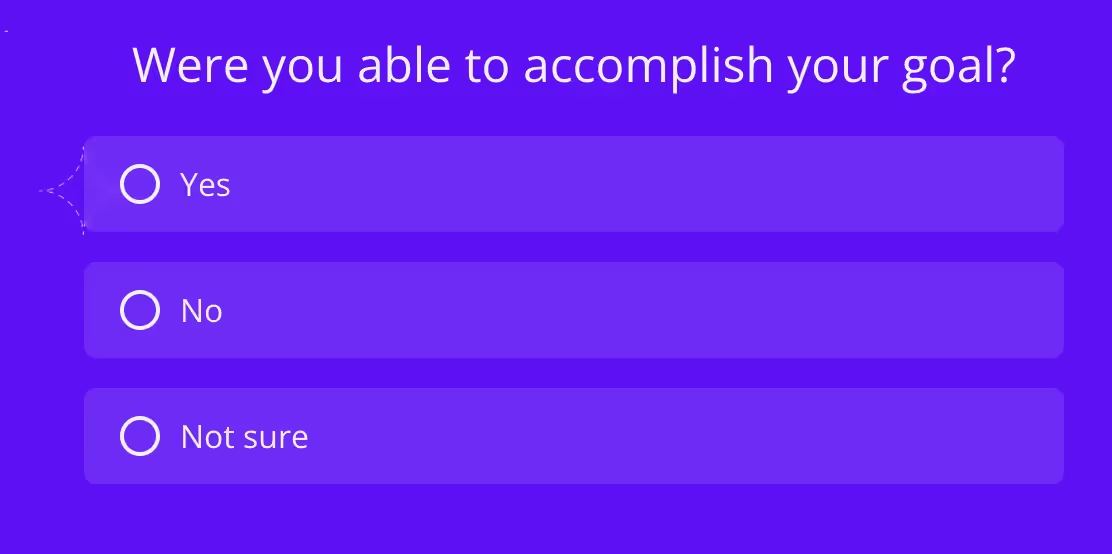
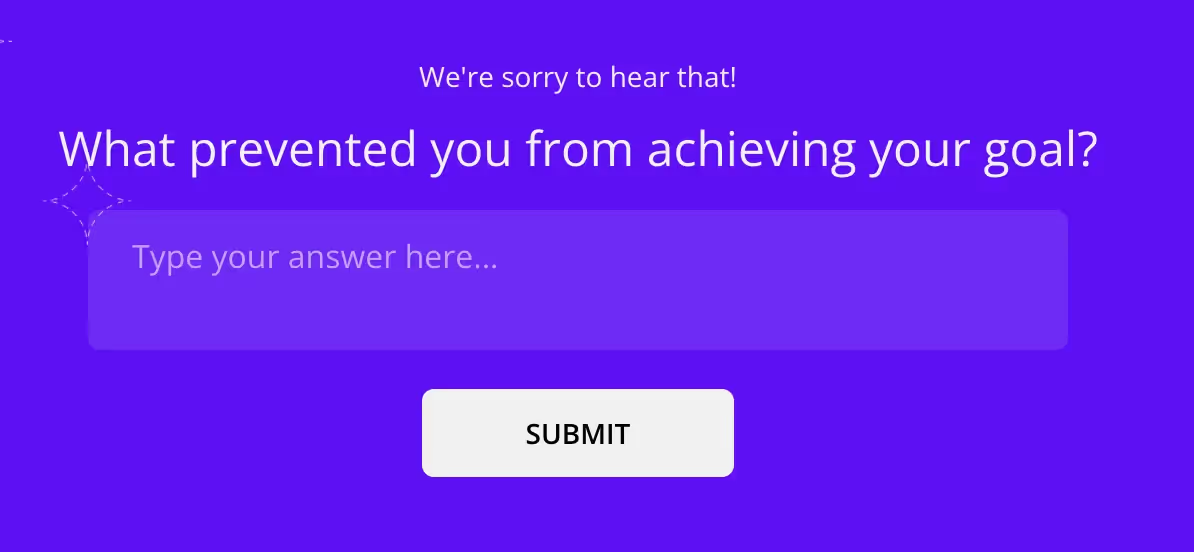
If you use the Survicate CES survey template, the last question follow-up would appear for customers who did not have the best experience. This would be 5 or below on a 7-point scale and 3 or below on a 5-point scale.
Why? Because the longer the survey, the more likely it won't be 100% completed. Adding a progress bar may help.

But especially if a customer is already frustrated, you don’t want to bother them longer than necessary.
Survicate will still provide meaningful insights, even if customers don’t complete the survey. That in itself may be valuable data—that your survey is too long or complicated.
What is a good customer effort score?
There is no cross-industry customer effort score benchmark. This is because not all companies apply the official 7-point scale, and different average effort is required for customers to receive different services.
The rule of thumb is to aim for an average of 5 or 6 (on a 7-point scale). A perfect score of 7 likely means customers didn’t put in the effort to rate the business honestly. This could be because the survey appeared at an inappropriate time, e.g., a month after contact with customer service.
If the score is lower than 5, you probably should find and fix some struggles your customers face.
All in all, aim for growth in the score, not a particular number.
How to calculate the customer effort score?
The customer effort score is usually rated on a 5- or 7-point scale.

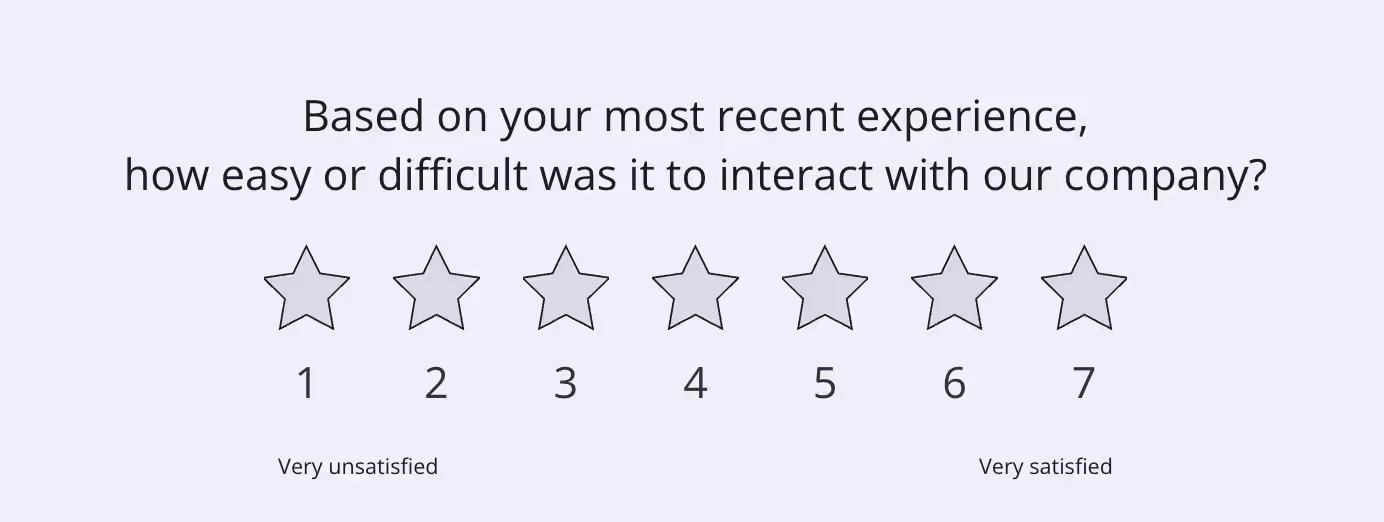
With a customer effort score survey software like Survicate, you can give customers the option to agree or disagree (Likert scale), provide numbers to rate their satisfaction (numbered scale), or provide emoticons (smiley scale) to show how happy they are with the product or service.
To get your CES score, divide the total sum of your scores by the total number of responses. Bear in mind what kind of scale you are using.
.avif)
On a 5-point scale,
- If you get 45 responses and a total score of 180, your CES would be 4. That’s pretty good!
On a 7-point scale,
- If you get 45 responses and a total score of 180, your CES would still be 4. But that would mean there is room for improvement.
If you prefer the customer effort score definition as a number between 0-100, 4/5 would be a CES score of 80, while 4/7 would be about 57.
If you use great customer effort score software like Survicate, you don’t have to calculate anything. That will be done for you. We will even prepare visual formats ready to use at your next presentation with the stakeholders!
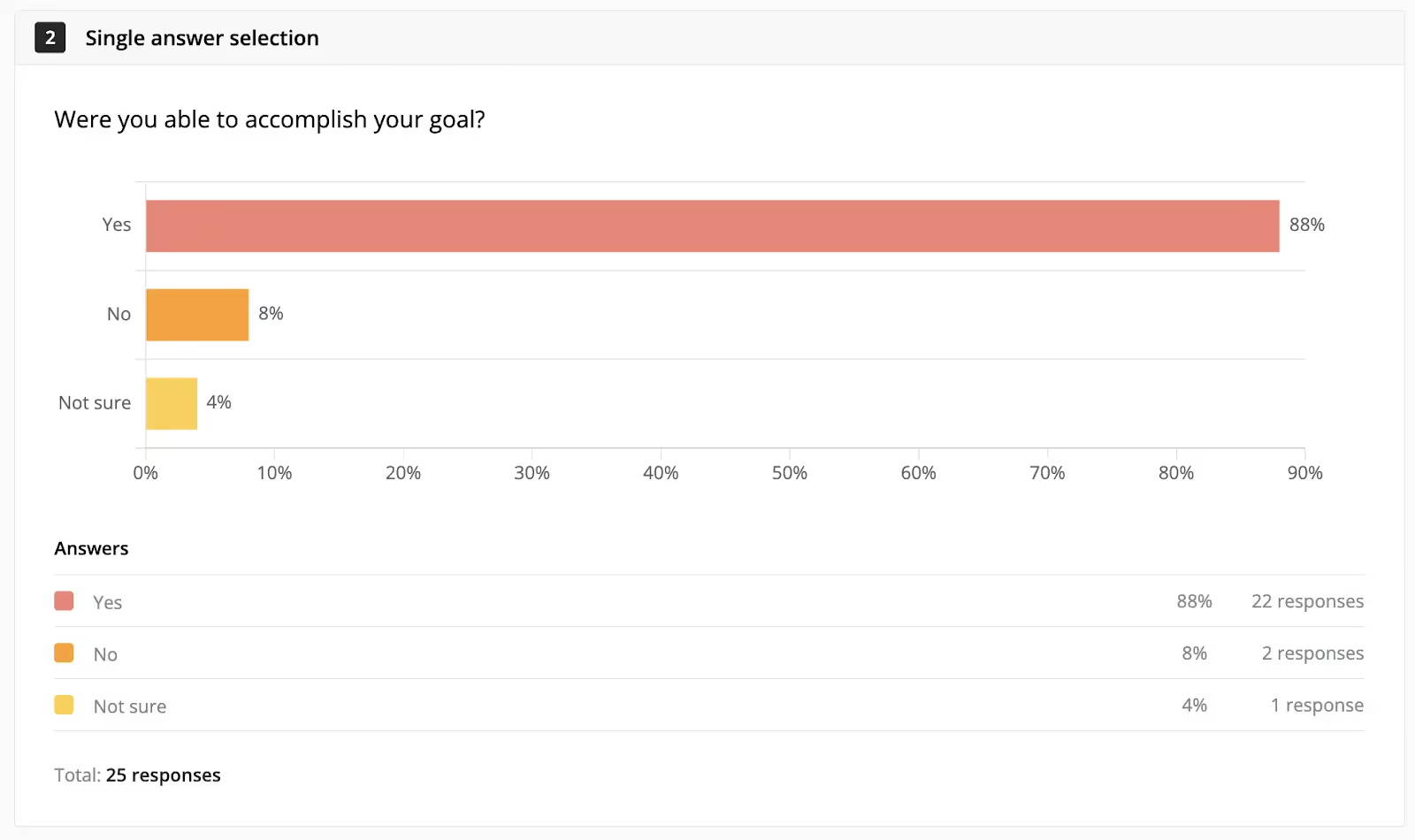
How to improve your customer effort score?
The goal is to reduce customer effort at all possible touchpoints. Use a customer effort tool like Survicate to run surveys at appropriate times. This will help you pinpoint moments when customers begin to feel frustrated.
The next step is to fix the struggles. Don’t just gather data, and don't stop at analyzing—troubleshoot! In other words, remember to close the feedback loop.
Each struggle you find is an opportunity for optimization. As a business or product owner, you should invest your efforts in this area.
Here are some examples of why the CES score may be below:
⚙️ a complicated user interface
⚙️ slow loading time of the website
⚙️ illogical customer journey
⚙️ lack of appropriate filters or categories (especially for products)
⚙️ broken/empty/thin content pages
⚙️ unresponsive or unhelpful customer service representative
⚙️ limited payment options
⚙️ no trial periods
⚙️ a glitch on the website
Once you identify where the struggles are, reach out to the appropriate team to make adjustments.
Make sure you offer the best customer service in preferred channels—make it easy and low-effort for customers to contact you. A CES survey will also tell you the most common way a customer interacts with your business.
Many customers prefer contact with representatives as a last resort. Provide Help Centers and FAQ sections. The end of such text is an excellent place for a quick CES survey.

At Survicate, we end each Help Center article with this simple smiley survey.
This lets us know whether the text helped customers resolve their issues or whether they had to contact customer support anyway. If so, this would be an opportunity to improve help-based content. We use their feedback to update these regularly.
What’s more, a well-made CES survey will also help you pinpoint the sore points that should be explained in such pieces of content.
A CES survey can also help you find peak hours for your business. You can then have more staff online or by phone to accommodate for the extra support needed. Quick response times from customer service significantly increase CES, NPS, and CSAT scores.
Customer Effort Score (CES): pros and cons
Let’s break down what’s best and worst about Customer Effort Score surveys.
First things first, a CES score is the strongest predictor of future purchase behavior and potential referral. The open-ended questions provide actionable insights and sore points in digital journeys, and a CES survey is easy to implement.
On the flip side, a CES score provides no information about overall customer satisfaction and must be sent immediately after an interaction.
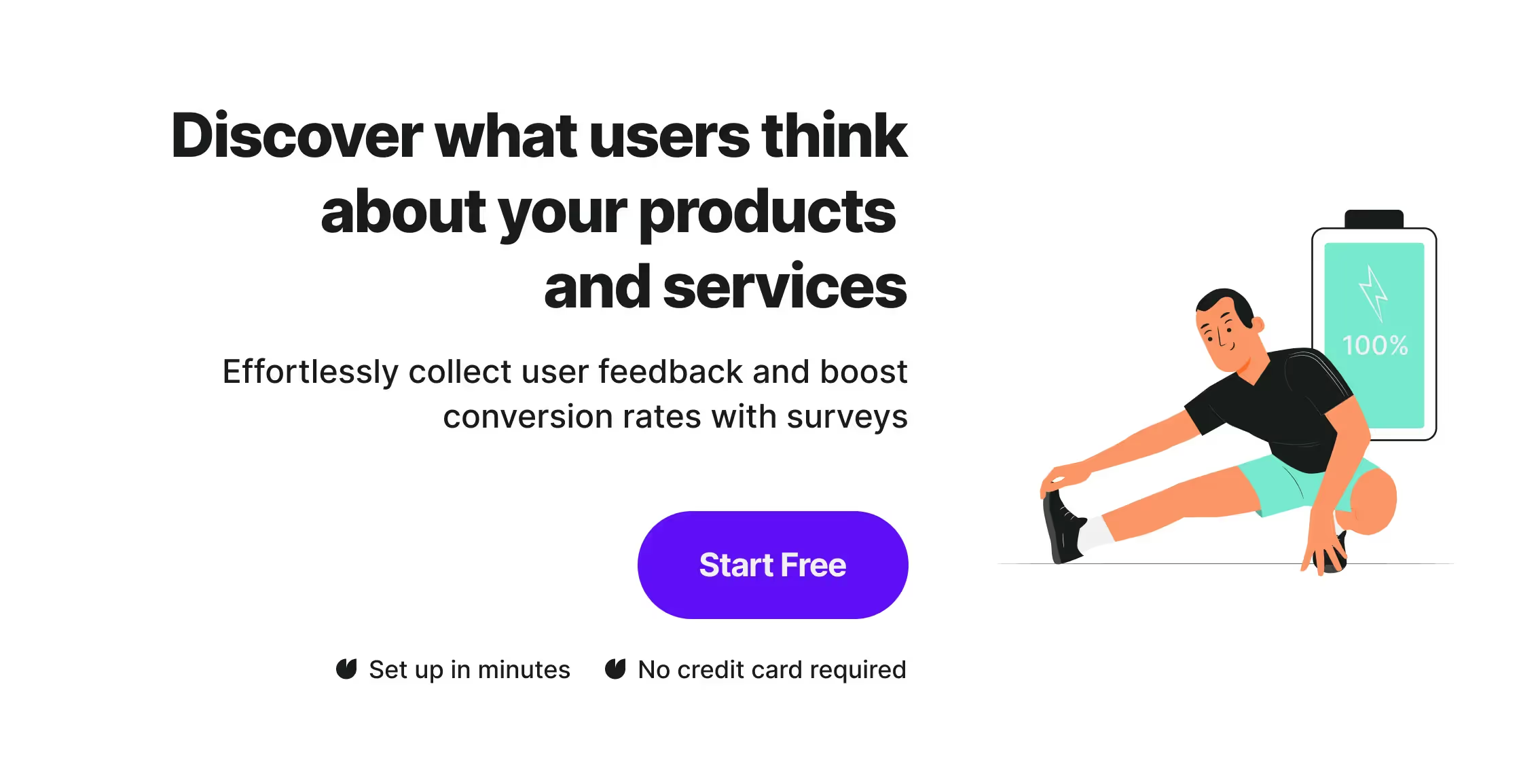
What’s the bottom line?
Measuring your customer effort score will help you retain customers, minimize customer service costs, and find opportunities for optimization in your business. Using survey tools like Survicate can help you make the process effortless 😎.
But don’t stop there. Use a CES survey to get customer feedback at critical touchpoints, but supplement it with NPS and CSAT surveys to get a complete picture and fine-tune your customers’ experience.
Also, you can foster your decision-making by checking our newest ranking of best customer satisfaction tools.
Experience the magic of customer feedback analysis with a free Survicate account. Sign up for our 10-day trial, which includes access to essential features, and visit our pricing.








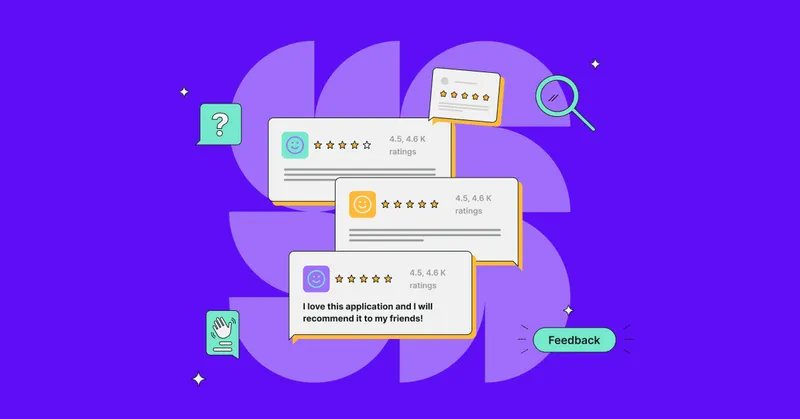
.webp)
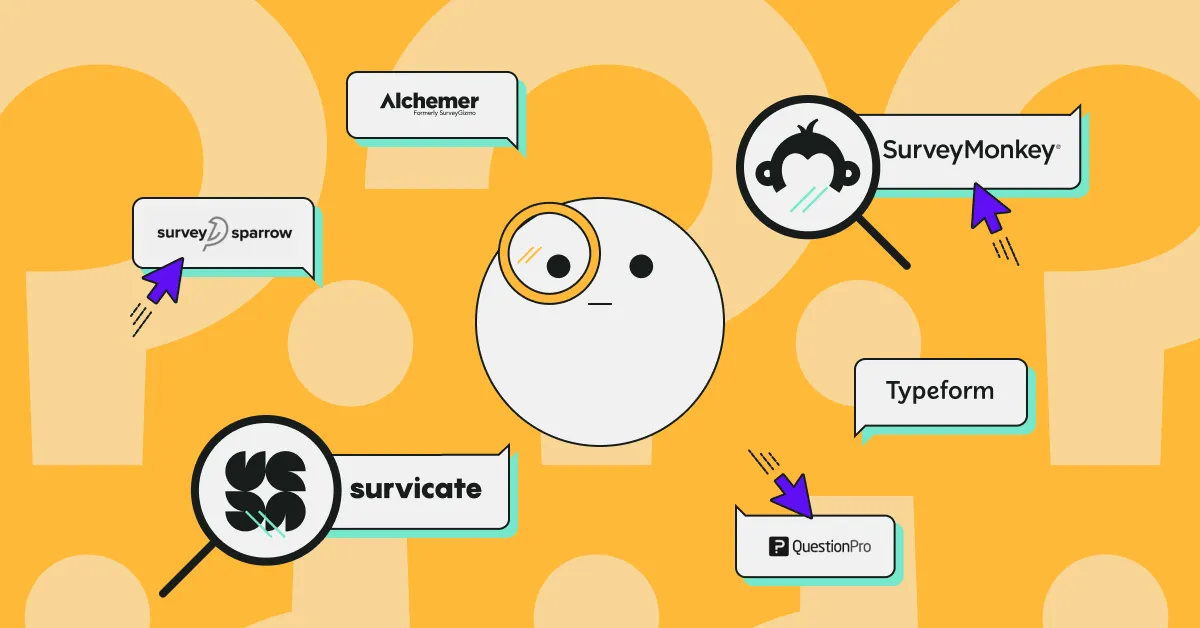
.png)



.svg)

.svg)



